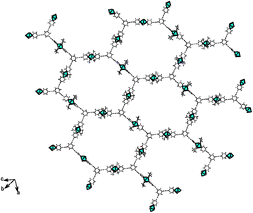The interaction between copper(II) hexafluoroacetylacetonate [Cu(hfacac)2] and pyridine-containing building blocks with linear, angled and trigonal geometry (1–3) has led to isolation of different coordination polymers (A–D). These were studied by infrared spectroscopy and single-crystal X-ray diffraction methods. The copper coordination geometry in the present complexes can be described as a more or less distorted square bipyramid (or elongated octahedron). The unsaturated Cu(hfacac)2 units are connected by the aromatic spacer ligand moieties 1–3 so as to form polymeric frameworks, which are infinite either in one (A and D) or in two dimensions (C). The polymeric ropes or sheets are held together in the crystals by relatively weak intermolecular interactions, in which the protruding fluoro substituents of the metallic links play an active role. The porous compound A was also studied with respect to sensing reactions for potential analysis of selected volatile compounds. The screening shows interesting reactions of this coordination polymer, indicating a reversible response of relatively small and polar analytes such as methanol, ethanol and acetone, but not of water.

You have access to this article
 Please wait while we load your content...
Something went wrong. Try again?
Please wait while we load your content...
Something went wrong. Try again?


 Please wait while we load your content...
Please wait while we load your content...